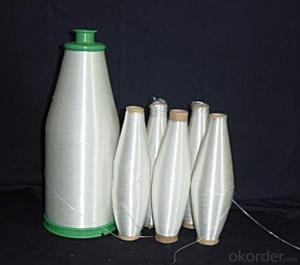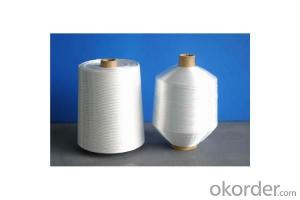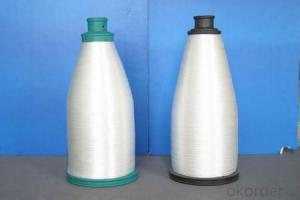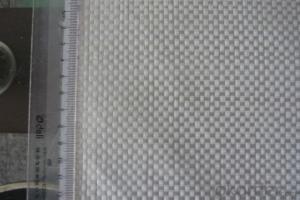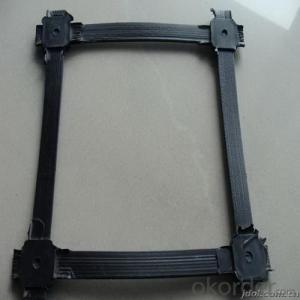C/E Fiber Glass Yarns with Best Price and Quality
- Loading Port:
- China Main Port
- Payment Terms:
- TT or LC
- Min Order Qty:
- 2000kg kg
- Supply Capability:
- -
OKorder Service Pledge
OKorder Financial Service
You Might Also Like
Description:
C or E textile glass a kind of additional twisting and plying yam. With the characteristics of high strength, corrosion resistance, heat resistance and high moisture absorption, no alkali yam has high electric insulation, so it used to produce weaved wires and cables’ wrap cladding, protection sleeve, train of mine, insulation materials of electric machinery, every yam of woven cloth and other industrial yam. It can also supply big and little paper cube and other cube yams with different shapes and different roll weight.
Product Features:
● Good Dispersibility.
● Less fuzzy.
● Density Even.
 Product Specifications:
Product Specifications:
Product Code | Tex | diameter (um) | Sizing. | breaking strength | Twist |
CC7.5-22-1/2 110S | 44 | 7.5 | paraffin | ≥15.5 | 110±10 |
EC9-33-1/2 65S | 66 | 9 | ≥24.1 | 65±5 | |
EC8-25-1/2 65S | 50 | 8 | ≥19.2 | 65±5 | |
CC9-33-1/2 65S | 33 | 9 | ≥20.6 | 65±5 | |
CC11-44-6/0 | 264 | 11 | ≥81.6 | ||
CC11-44-1/3 110S | 132 | 11 | silane | ≥40.8 | 28±3 |
EC9-68-1/0 28Z | 68 | 9 | ≥18.0 | 28±3 |
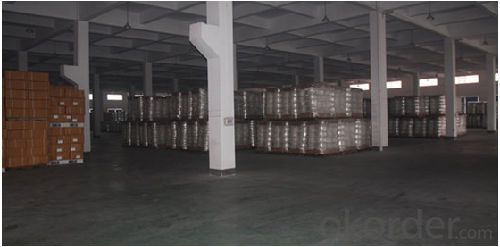
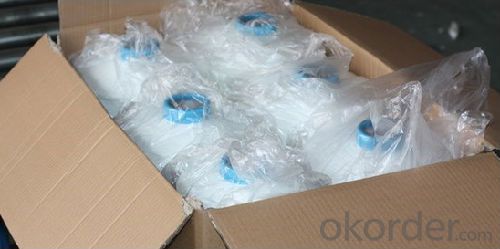
Storage:
Unless otherwise specified,It should be stored in a dry, cool and rain-proof area. It is recommended that the room temperature and humidity should be always maintained at 15℃~35℃ and 35%~65% respectively.
packaging:
with cartons
FAQ:
1.What is the delivery time ?
15days after receiving the deposit
2.Are you a trading company or factory.
We are factory,and we have more than 10 years of experience.
- Q:What are the different weight options for fiberglass fabric?
- Fiberglass fabric comes in various weight options, which determine its thickness and density. Manufacturers and intended applications can influence the weight options available. Fiberglass fabric weight is typically measured in ounces per square yard (oz/yd²) or grams per square meter (g/m²). Different weight options for fiberglass fabric exist, depending on the manufacturer and intended use. Common weight options include 1.5 oz/yd², 3 oz/yd², 6 oz/yd², 9 oz/yd², and 18 oz/yd². These weights indicate the number of fiberglass strands per unit area, with higher weights indicating a denser fabric. Lighter weight fiberglass fabrics, like 1.5 oz/yd², find application in projects requiring flexibility and a smooth finish, such as surfboards, model airplanes, and lightweight structures. The automotive industry also commonly utilizes them for interior parts or as reinforcement in composite materials. Medium weight fiberglass fabrics, ranging from 3 oz/yd² to 9 oz/yd², serve general-purpose applications, including boat building, mold making, and repairing or reinforcing structures. These weight options strike a balance between flexibility and strength, making them suitable for a wide range of projects. Heavier weight fiberglass fabrics, such as 18 oz/yd², come into play when maximum strength and durability are necessary. They find common use in industrial applications like tank and pipe wrapping, as well as in the construction industry for reinforcing concrete or other structural elements. It is important to consider that the weight of fiberglass fabric is just one factor to contemplate when choosing the appropriate fabric for a specific application. Other factors, like weave pattern, resin compatibility, and intended use, should also be taken into account to ensure the desired performance and outcome.
- Q:Are fiberglass fabrics resistant to mold or mildew?
- Yes, fiberglass fabrics are generally resistant to mold or mildew. This is due to their non-porous nature and the fact that they do not provide the ideal conditions for mold or mildew growth. Fiberglass fabrics are commonly used in applications where moisture resistance is required, such as in outdoor furniture, boat covers, and shower curtains. However, it is important to note that while fiberglass fabrics themselves are resistant to mold or mildew, if they are coated or covered with organic materials such as dirt, dust, or other organic matter, there is still a possibility for mold or mildew growth on the surface. Therefore, regular cleaning and maintenance of fiberglass fabrics is recommended to ensure their longevity and resistance to mold or mildew.
- Q:What is the maximum width available for fiberglass fabric rolls?
- The maximum width available for fiberglass fabric rolls can vary, but typically it ranges from 1 meter (39 inches) to 3 meters (118 inches).
- Q:Can fiberglass fabrics be used for insulation in pipelines?
- Yes, fiberglass fabrics can be used for insulation in pipelines. They are commonly used due to their excellent thermal insulation properties, high temperature resistance, and durability.
- Q:Does anyone know what kind of sculpture of glass fiber reinforced plastic sculpture is?
- Generally large items to see more, and are not particularly expensive. But it's more expensive than the average stone carving because you want to turn the mold and the clay.
- Q:How do fiberglass fabrics perform in terms of chemical resistance?
- Fiberglass fabrics have excellent chemical resistance properties, making them highly resistant to a wide range of chemicals. They can withstand exposure to acids, bases, solvents, and other corrosive substances without significant degradation or damage. This makes fiberglass fabrics a suitable choice for various applications where chemical resistance is critical, such as in the manufacturing of protective clothing, chemical storage tanks, and filtration systems.
- Q:How does fiberglass fabric compare to other types of fabrics?
- Distinguishing itself from other fabric types, fiberglass fabric boasts several distinct characteristics. Firstly, its incredible strength and durability render it ideal for situations where robustness is paramount, such as in industrial settings or outdoor equipment. Withstanding heavy loads and stress without tearing or stretching, it exhibits a commendable tensile strength. Secondly, fiberglass fabric exhibits remarkable resistance to heat and fire. Possessing a high melting point and a propensity to resist catching fire, it stands as a suitable option for applications concerned with fire safety, such as insulation materials or protective clothing. Moreover, fiberglass fabric showcases resistance to chemicals and corrosion. Unreactive towards most chemicals, acids, or alkalis, it finds suitability in environments frequently exposed to corrosive substances, such as chemical plants or laboratories. Furthermore, fiberglass fabric offers the advantage of being lightweight and flexible. Despite its strength, it remains non-bulky and easy to handle. This flexibility enables its application in various scenarios that require a certain degree of flexibility, including the construction of curved surfaces or the manufacturing of composite materials. Nevertheless, fiberglass fabric does have some drawbacks. It lacks the comfort and softness of other fabric types, diminishing its appeal in certain applications like clothing or upholstery. Additionally, it tends to be more costly than certain alternative fabric options. Overall, fiberglass fabric emerges as an exceptionally versatile material, embodying exceptional strength, durability, heat resistance, chemical resistance, and flexibility. While it may not be universally suitable, it represents an excellent choice for those seeking its unique properties.
- Q:What are the weight options for fiberglass fabric?
- Fiberglass fabric, also known as glass fiber cloth, is available in a variety of weight options to suit different applications. The weight of fiberglass fabric is typically measured in ounces per square yard (oz/yd²) or grams per square meter (g/m²). The weight options for fiberglass fabric can range from as low as 0.5 oz/yd² (17 g/m²) to as high as 32 oz/yd² (1086 g/m²) or even more. The weight of fiberglass fabric determines its thickness, strength, and durability. Lighter weight fiberglass fabrics are often used for applications that require high flexibility and conformability, such as in the manufacturing of circuit boards or for reinforcing and repairing small parts. They are also commonly used in aviation and aerospace industries, where weight reduction is crucial. On the other hand, heavier weight fiberglass fabrics are typically used in applications that require higher strength and impact resistance. These can include boat building, automotive parts manufacturing, construction, and even in the production of bulletproof vests and armor. It is important to note that the weight of fiberglass fabric is just one factor to consider when choosing the right fabric for a specific application. Other factors like weave pattern, finish, and resin compatibility should also be taken into account to ensure optimal performance.
- Q:How do fiberglass fabrics perform in terms of abrasion resistance?
- Fiberglass fabrics are known for their exceptional abrasion resistance properties. Due to the nature of the material, which consists of fine fibers of glass woven together, they offer high resistance to wear and tear caused by rubbing or scraping against rough surfaces. This makes fiberglass fabrics highly durable and suitable for applications that require protection against abrasion, such as industrial and automotive sectors. Additionally, fiberglass fabrics often have a smooth surface finish, further enhancing their ability to withstand friction and maintain their integrity over time. Overall, fiberglass fabrics are considered to be excellent performers in terms of abrasion resistance.
- Q:Do fiberglass fabrics require any special care or maintenance?
- Yes, fiberglass fabrics do require some special care and maintenance to ensure their longevity and performance. Here are a few important points to consider: 1. Cleaning: Regular cleaning is necessary to remove dirt, dust, and other debris that can accumulate on the fabric's surface. Use a soft brush or cloth to gently scrub the fabric, and avoid using harsh chemicals or abrasive cleaners that can damage the fabric. 2. Storing: When not in use, fiberglass fabrics should be stored properly to prevent any damage. It is recommended to store them in a clean and dry place, away from direct sunlight or extreme temperatures. Rolling the fabric instead of folding it can also help prevent creasing or wrinkling. 3. Avoiding sharp objects: Fiberglass fabrics are generally durable, but they can be punctured or torn by sharp objects. It is important to keep sharp objects away from the fabric and handle it with care to avoid any accidental damage. 4. UV protection: While fiberglass fabrics are inherently resistant to UV rays, prolonged exposure to direct sunlight can cause fading or degradation over time. To protect the fabric, it is advisable to use UV protective sprays or coatings, or to provide shading when used outdoors. 5. Repairing: If any damage occurs, it is important to address it promptly to prevent further deterioration. Small holes or tears can be repaired using specialized fiberglass patch kits or adhesive tapes. For larger damages, it is recommended to seek professional repair services. By following these guidelines, fiberglass fabrics can maintain their appearance and functionality for an extended period, ensuring that they continue to serve their intended purpose effectively.
1. Manufacturer Overview |
|
|---|---|
| Location | |
| Year Established | |
| Annual Output Value | |
| Main Markets | |
| Company Certifications | |
2. Manufacturer Certificates |
|
|---|---|
| a) Certification Name | |
| Range | |
| Reference | |
| Validity Period | |
3. Manufacturer Capability |
|
|---|---|
| a)Trade Capacity | |
| Nearest Port | |
| Export Percentage | |
| No.of Employees in Trade Department | |
| Language Spoken: | |
| b)Factory Information | |
| Factory Size: | |
| No. of Production Lines | |
| Contract Manufacturing | |
| Product Price Range | |
Send your message to us
C/E Fiber Glass Yarns with Best Price and Quality
- Loading Port:
- China Main Port
- Payment Terms:
- TT or LC
- Min Order Qty:
- 2000kg kg
- Supply Capability:
- -
OKorder Service Pledge
OKorder Financial Service
Similar products
New products
Hot products
Hot Searches
Related keywords

